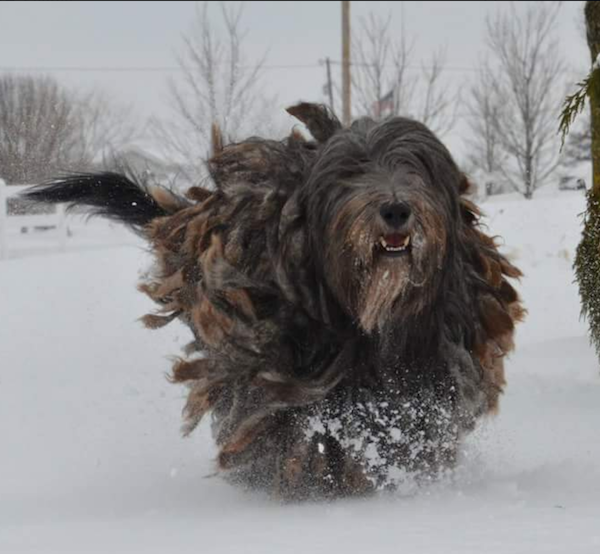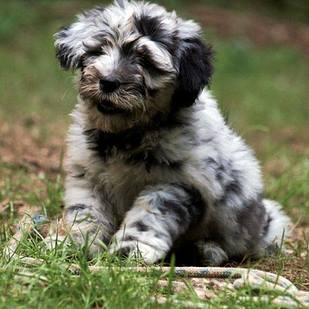
Behold an adult Bergamasco flying through snow.
Unlike the corded coat of Pulik, Komondorok, Havanese and Poodles, the strands of a Bergamasco’s coat weave together creating flat layers of hair referred to as “flocks.” They begin to develop somewhere after a puppy’s 6-8th month birthday. Until then, a puppy looks like the picture below:
As the puppy matures, the coat is always changing, first from the soft, “bury-my-face-in-it” puppy coat, to the flocking stage best described as resembling an unmade bed. The picture above is the “bury-my-face-in-it” puppy stage.
Somewhere along the way (usually when the dog is around three years old) the Eureka! moment arrives when the flocks emerge and the dog looks like a real Bergamasco. That said, a Bergamasco is more than its unique look. The breed is wicked smart, and no offense to humans, but they see themselves as their owner’s equal.
Here was our interview (complete with a rocky beginning) with a veteran Bergamasco owner at the AKC National Championship 2017 presented by Royal Canin:
If this breed interests you, you should know that the oldest kennel in Italy is the Valle Scrivia owned by the Cavalchini family. It was after WWII that Annibale Guidobono Cavalchini returned home from the mountains and began to reorganize the family farm with an eye for livestock and a kennel. In time, a Boxer would come to live in the garden complete with a modern shelter, but it would be Bergamaschi (plural for Bergamasco) that ruled the pastures.
Cavalchini recounted his fascination with the breed he first saw when shepherds from the Alps came down to the valley for work and brought their dogs. In particular, he remembered an evening when he was alerted that one of his cows had gone missing. Not knowing what else to do, he asked a shepherd for help. That shepherd had his oldest Bergamasco, “Bortolo,” smell another heifer, then directed the dog to find the beast. After less than half an hour, “Bortolo” was heard barking. Another eureka moment. He had found the heifer that had fallen into a “foppa” covered with brambles.
The Valle Scrivia was one of the kennels that helped bolster Bergamasco numbers that had decreased even before the war when wool production decreased, and so had the need for sheepdogs. The war made things worse, but through the efforts of an Italian breeder, Dr. Maria Andreoli, the breed was saved from extinction, in part because of her understanding of genetics.
Image of an adult Bergmasco by Susan Pickerill of Windy Hill Bergamascos

